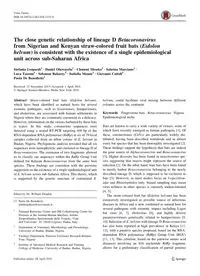
2016 The close genetic relationship of lineage DBetacoronavirusfrom Nigerian and Kenyan straw-colored fruit bats (Eidolo PDF
Preview 2016 The close genetic relationship of lineage DBetacoronavirusfrom Nigerian and Kenyan straw-colored fruit bats (Eidolo
The close genetic relationship of lineage D Betacoronavirus from Nigerian and Kenyan straw-colored fruit bats (Eidolon helvum) is consistent with the existence of a single epidemiological unit across sub-Saharan Africa Stefania Leopardi1 • Daniel Oluwayelu2 • Clement Meseko3 • Sabrina Marciano1 • Luca Tassoni1 • Solomon Bakarey4 • Isabella Monne1 • Giovanni Cattoli1 • Paola De Benedictis1 Received: 23 November 2015 / Accepted: 1 April 2016 � Springer Science+Business Media New York 2016 Abstract Straw-colored fruit bats (Eidolon helvum), which have been identified as natural hosts for several zoonotic pathogens, such as lyssaviruses, henipaviruses, and ebolavirus, are associated with human settlements in Nigeria where they are commonly consumed as a delicacy. However, information on the viruses harbored by these bats is scarce. In this study, coronavirus sequences were detected using a nested RT-PCR targeting 440 bp of the RNA-dependent RNA polymerase (RdRp) in six of 79 fecal samples collected from an urban colony of E. helvum in Ibadan, Nigeria. Phylogenetic analysis revealed that all six sequences were monophyletic and clustered in lineage D of Betacoronavirus. The extension of two fragments allowed us to classify our sequences within the RdRp Group Unit defined for Kenyan Betacoronavirus from the same host species. These findings are consistent with the previous suggestion on the existence of a single epidemiological unit of E. helvum across sub-Saharan Africa. This theory, which is supported by the genetic structure of continental E. helvum, could facilitate viral mixing between different colonies across the continent. Keywords Frugivorous bats � Betacoronavirus � Nigeria � Epidemiological niche Bats are known to carry a wide variety of viruses, some of which have recently emerged as human pathogens [1]. Of these, coronaviruses (CoVs) are particularly widely dis- tributed, having been described worldwide and in almost every bat species that has been thoroughly investigated [2]. These findings support the hypothesis that bats are indeed the gene source of Alphacoronavirus and Betacoronavirus [3]. Higher diversity has been found in insectivorous spe- cies suggesting that insects might represent the source of infection [2]. On the other hand, fruit bats have been found to mostly harbor Betacoronavirus belonging to the newly described lineage D, which is supposed to be exclusive to bats [3]. However, as most studies focus on Vespertilion- idae and Rhinolophidea only, biased sampling may mean virus richness in other species is currently underestimated [4, 5]. The straw-colored fruit bat (Eidolon helvum) has been extensively investigated as possible source of infectious diseases in Africa and is now confirmed as natural host for several pathogens with zoonotic impact including Lagos bat virus [6, 7], ebolavirus [8], and highly diverse paramyxoviruses genetically related to henipaviruses [9, 10]. Infection of E. helvum with lineage D Betacoronavirus has also been reported at high prevalence in Kenya [11, 12], with a putative species proposed, based on the RNA- dependent RNA polymerase (RdRp) Group Unit (RGU) [11, 13]. This criterion, based on the pairwise amino acid distances involving an 816 nucleotide RdRp fragment, allows for a preliminary classification of partial genome Edited by Dr. William Dundon. & Paola De Benedictis
